Related Research Articles

Sir Alexander Fleming was a Scottish physician and microbiologist, best known for discovering the world's first broadly effective antibiotic substance, which he named penicillin. His discovery in 1928 of what was later named benzylpenicillin from the mould Penicillium rubens has been described as the "single greatest victory ever achieved over disease". For this discovery, he shared the Nobel Prize in Physiology or Medicine in 1945 with Howard Florey and Ernst Boris Chain.
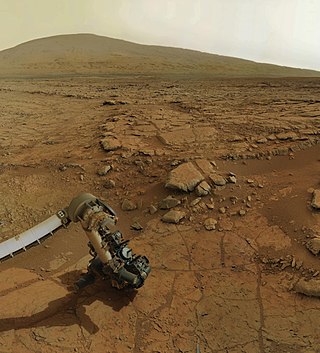
Astrobiology, is a scientific field within the life and environmental sciences that studies the origins, early evolution, distribution, and future of life in the universe by investigating its deterministic conditions and contingent events. As a discipline, astrobiology is founded on the premise that life may exist beyond Earth.
Extraterrestrial life, alien life, or colloquially aliens, is life which does not originate from Earth. No extraterrestrial life has yet been conclusively detected. Such life might range from simple forms such as prokaryotes to intelligent beings, possibly bringing forth civilizations that might be far more advanced than humans. The Drake equation speculates about the existence of sapient life elsewhere in the universe. The science of extraterrestrial life is known as astrobiology.

Streptomycin is an antibiotic medication used to treat a number of bacterial infections, including tuberculosis, Mycobacterium avium complex, endocarditis, brucellosis, Burkholderia infection, plague, tularemia, and rat bite fever. For active tuberculosis it is often given together with isoniazid, rifampicin, and pyrazinamide. It is administered by injection into a vein or muscle.
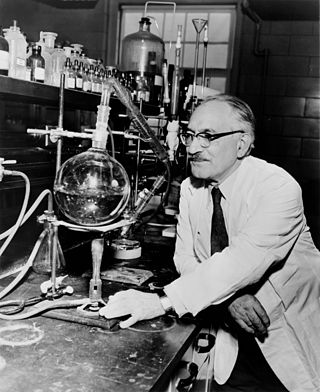
Selman Abraham Waksman was a Jewish Ukrainian inventor, Nobel Prize laureate, biochemist and microbiologist whose research into the decomposition of organisms that live in soil enabled the discovery of streptomycin and several other antibiotics. A professor of biochemistry and microbiology at Rutgers University for four decades, he discovered several antibiotics, and he introduced procedures that have led to the development of many others. The proceeds earned from the licensing of his patents funded a foundation for microbiological research, which established the Waksman Institute of Microbiology located at the Rutgers University Busch Campus in Piscataway, New Jersey (USA). In 1952, he was awarded the Nobel Prize in Physiology or Medicine for "ingenious, systematic, and successful studies of the soil microbes that led to the discovery of streptomycin." Waksman and his foundation later were sued by Albert Schatz, one of his Ph.D. students and the discoverer of streptomycin, for minimizing Schatz's role in the discovery.
Xenoarchaeology, a branch of xenology dealing with extraterrestrial cultures, is a hypothetical form of archaeology that exists mainly in works of science fiction. The field is concerned with the study of the material remains to reconstruct and interpret past life-ways of alien civilizations. Xenoarchaeology is not currently practiced by mainstream archaeologists due to the current lack of any material for the discipline to study.
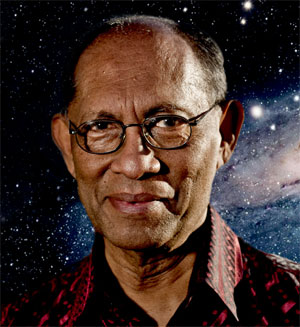
Nalin Chandra Wickramasinghe is a Sri Lankan-born British mathematician, astronomer and astrobiologist of Sinhalese ethnicity. His research interests include the interstellar medium, infrared astronomy, light scattering theory, applications of solid-state physics to astronomy, the early Solar System, comets, astrochemistry, the origin of life and astrobiology. A student and collaborator of Fred Hoyle, the pair worked jointly for over 40 years as influential proponents of panspermia. In 1974 they proposed the hypothesis that some dust in interstellar space was largely organic, later proven to be correct.

Albert Israel Schatz was an American microbiologist and academic who discovered streptomycin, the first antibiotic known to be effective for the treatment of tuberculosis. He graduated from Rutgers University in 1942 with a bachelor's degree in soil microbiology, and received his doctorate from Rutgers in 1945. His PhD research led directly to the discovery of streptomycin.
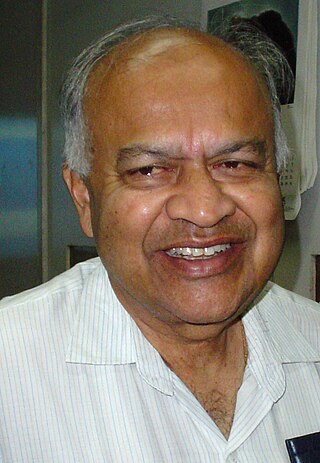
Jayant Vishnu Narlikar is an Indian astrophysicist and emeritus professor at the Inter-University Centre for Astronomy and Astrophysics (IUCAA). He developed with Sir Fred Hoyle the conformal gravity theory, known as Hoyle–Narlikar theory. It synthesises Albert Einstein's theory of relativity and Mach's principle. It proposes that the inertial mass of a particle is a function of the masses of all other particles, multiplied by a coupling constant, which is a function of cosmic epoch.
In microbiology, pleomorphism, also pleiomorphism, is the ability of some microorganisms to alter their morphology, biological functions or reproductive modes in response to environmental conditions. Pleomorphism has been observed in some members of the Deinococcaceae family of bacteria. The modern definition of pleomorphism in the context of bacteriology is based on variation of morphology or functional methods of the individual cell, rather than a heritable change of these characters as previously believed.
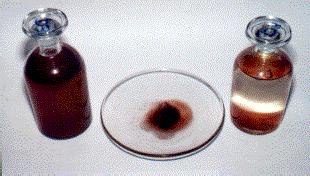
The Kerala red rain phenomenon was a blood rain event that occurred in Wayanad district of southern Indian state Kerala on Monday, 15 July 1957 and the colour subsequently turned yellow and also 25 July to 23 September 2001, when heavy downpours of red-coloured rain fell sporadically in Kerala, staining clothes pink. Yellow, green and black rain was also reported. Coloured rain was also reported in Kerala in 1896 and several times since, most recently in June 2012, and from 15 November 2012 to 27 December 2012 in eastern and north-central provinces of Sri Lanka.
GodfreyLouis is a solid-state physicist from India. His hypotheses about the "red rain" phenomenon in Kerala have attracted controversy. In April 2008, he published a paper in which he hypothesised that samples of particles from the "blood-coloured" rain that fell in his state of Kerala, India in the summer of 2001 were the result of a comet disintegrating in the upper atmosphere which comprised mainly microbes from outer space. The paper drew much media interest. Other scientists disagreed early on with Louis' hypothesis regarding the red rain's origin. An earlier (2001) study by the Centre for Earth Science Studies, Kerala, India, reported that the red rain was the result of spores from local algae.

The Waksman Institute of Microbiology is a research facility on the Busch Campus of Rutgers University. It is named after Selman Waksman, a student and then faculty member at Rutgers who won the Nobel Prize for Medicine in 1952 for research which led to the discovery of streptomycin. The institute conducts research on microbial molecular genetics, developmental molecular genetics, plant molecular genetics, and structural and computational biology.

Streptomyces griseus is a species of bacteria in the genus Streptomyces commonly found in soil. A few strains have been also reported from deep-sea sediments. It is a Gram-positive bacterium with high GC content. Along with most other streptomycetes, S. griseus strains are well known producers of antibiotics and other such commercially significant secondary metabolites. These strains are known to be producers of 32 different structural types of bioactive compounds. Streptomycin, the first antibiotic ever reported from a bacterium, comes from strains of S. griseus. Recently, the whole genome sequence of one of its strains had been completed.
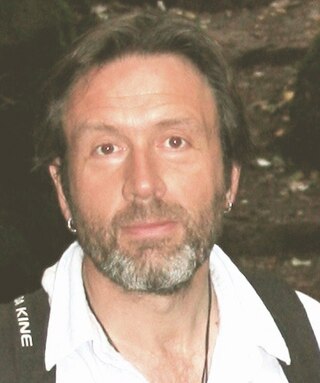
Mark Brake is a Welsh author, broadcaster and former professor of science communication at the University of Glamorgan.
Julian Edmund Davies is a British-born microbiologist and Professor Emeritus in the Department of Microbiology and Immunology at the University of British Columbia.
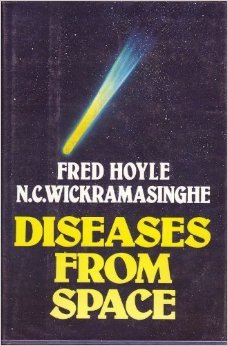
Diseases from Space is a book published in 1979 that was authored by astronomers Fred Hoyle and Chandra Wickramasinghe, where they propose that many of the most common diseases which afflict humanity, such as influenza, the common cold and whooping cough, have their origins in extraterrestrial sources. The two authors argue the case for outer space being the main source for these pathogens or at least their causative agents.
Harold Boyd Woodruff was an American soil microbiologist and a member of the National Academy of Sciences.
A state microbe is a microorganism used as an official state symbol. Several U.S. states have honored microorganisms by nominating them to become official state symbols. The first state to declare an Official State Microbe is Oregon which chose Saccharomyces cerevisiae as the Official Microbe of the State of Oregon in 2013 for its significance to the craft beer industry in Oregon. One of the first proponents of State Microbes was microbiologist Moselio Schaechter, who, in 2010, commented on Official Microbes for the American Society for Microbiology's blog "Small Things Considered" as well as on National Public Radio's "All Things Considered".

Elizabeth Bugie Gregory was an American biochemist who co-discovered Streptomycin, the first antibiotic against Mycobacterium tuberculosis in Selman Waksman laboratory at Rutgers University. Waksman went on to win the Nobel Prize for Medicine in 1952 and took the credit for the discovery.
References
- ↑ "'Alien Bugs' Discovered In Earth's Atmosphere". news.sky.com. Retrieved 29 December 2014.
- ↑ "The truth IS out there (above Cheshire, that is): British scientists claim to have found proof of alien life - Science - News - The Independent" . independent.co.uk. 19 September 2013. Archived from the original on 15 May 2022. Retrieved 29 December 2014.
- ↑ "Astrobiologists Claim to Have Found Extraterrestrial Life Form in Earth's Stratosphere | Space Exploration | Sci-News.com". sci-news.com. Retrieved 29 December 2014.
- 1 2 3 4 5 6 7 8 9 10 11 12 University of Sheffield. "Milton Wainwright - Academic Staff - Molecular Biology and Biotechnology - The University of Sheffield". sheffield.ac.uk. Archived from the original on 4 March 2016. Retrieved 29 December 2014.
- ↑ "wainwrightscience". wainwrightscience.blogspot.co.uk. Retrieved 29 December 2014.
- ↑ "It's raining aliens". tmcnet.com. Retrieved 29 December 2014.
- ↑ Wainwright, Milton (2004). "Hitler's Penicillin". Perspectives in Biology and Medicine. 47 (2): 189–198. doi:10.1353/pbm.2004.0037. PMID 15259203. S2CID 29450203. Project MUSE 54167.[ non-primary source needed ]
- ↑ "Biochemical Society Essays in Biochemistry". all-portland.net. Archived from the original on 29 December 2014. Retrieved 29 December 2014.
- ↑ Veronique Mistiaen (2 November 2002). "Time, and the great healer". The Guardian. Retrieved 6 September 2022.
- ↑ "Milton Wainwright". British Centre for Science Education.